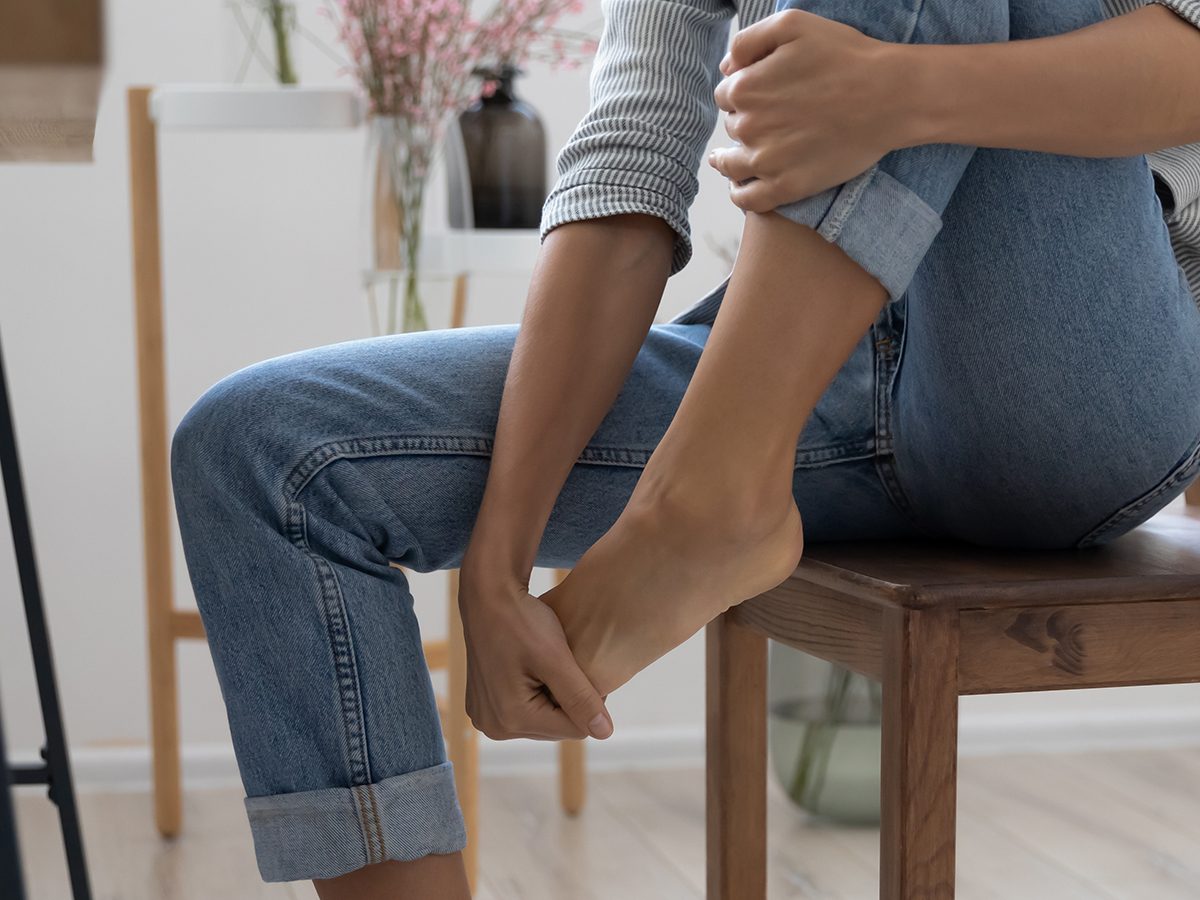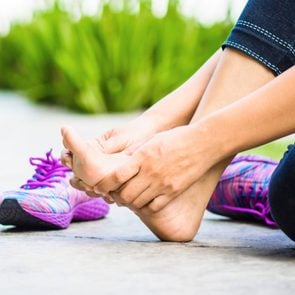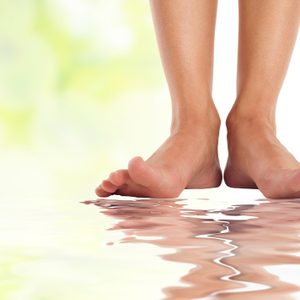The Scientific Reason a Stubbed Toe Hurts So Much (And What You Can Do About It)
Going barefoot or wearing open-toed shoes can lead to a stubbed toe. Whatever the cause, here's how to know if the injury is serious—and what you can do about the pain.
It’s the middle of the night and you wake up groggily in the dark to go to the bathroom, only to hit your toe on the night table. Why are you in such pain? Is your toe broken?
Simply thinking about hitting your toe—commonly called “stubbing your toe”—can make you wince. We’re all familiar with how terrible it feels and the pain that lingers. So, we asked podiatrists about exactly what’s happening when you do it and how to know if you’ve actually injured yourself.
What does it mean to stub your toe?
A stubbed toe simply means that “in the course of walking, you hit your forefoot against an object while barefoot or wearing an open-toed shoe,” says Michael Trepel, DPM, a podiatrist in New York City. “It happens far more frequently than you realize, but you’re wearing shoes, so you don’t really feel it,” he says.
Most of these injuries occur at home, often in the dark, and especially in the middle of the night when you can’t see your surroundings and are in a sleep-induced haze. Other times, you might be getting up quickly—to answer the phone or attend to a pot on the stove—and you hit your foot on the leg of a chair or dresser, Dr. Trepel says. (Learn why wearing flip-flops are bad for your feet.)
Why does a stubbed toe hurt so much?
Your feet—and specifically your toes—are your body’s windows to the world. “There are more dense nerve endings around the toes because you need the tactile sense,” says Dr. Trepel. “Therefore, an injury around the tip of the toe generates more pain than if it happened on the heel,” he says.
What toes are most likely to be stubbed?
In the Pensacola, Florida practice of podiatrist Grace Torres-Hodges, “the great toe (hallux) and pinky toe (fifth digit) seem to be the ones that are most likely to be stubbed—and I’d say that the fifth toe is in the lead,” she says. (Check out 13 more foot health facts podiatrists want you to know.)

The consequences of stubbing your toe
There are several things that can happen when you stub your toe:
Temporary pain
The pain goes away in a minute or so, you have not injured yourself, and you can resume normal activities. “It’s similar to hitting your ‘funny bone’,” says Dr. Torres-Hodges.
Broken bone
“This usually occurs when something comes in between the space between toes and forcibly separates them, which can result in a fracture,” Dr. Trepel says. What can also happen is that you bang your foot so hard, the direct impact breaks a bone. If you’ve broken your toe, you may notice swelling around the toe or foot, discolouration like black or blue bruising around the area, and extreme pain when you walk or put weight on the toe.
Ligament tear
Ligaments are flimsier compared to other structures in feet, and they can tear more easily, Dr. Trepel says.
Skin laceration
The impact breaks the skin and exposes the underlying soft tissue, says Dr. Torres-Hodges. You should look for bleeding.
Jam
This refers to “one or more of the joints in the toe that have become compressed,” says Dr. Torres-Hodges.
Nailbed injury
If your nail bears the brunt of the impact, this can cause bleeding under the nail, called a subungual hematoma. “There is a lot of bacteria around the nails, and so there’s a risk of infection with nailbed injuries,” says Dr. Trepel. Make sure to keep the area clean. If there’s a blood blister under the nail, a podiatrist can drain it. Otherwise, you may lose the nail. (Here’s what it could mean if you have white spots under your nails.)
Bruising
Immediately after or the next morning, your toe may be swollen and painful. Within a couple of days after the hit, you may notice that your toe turns black and blue. “The fact that bruising appears two days later isn’t clinically significant. It does not mean you broke it,” Dr. Trepel says. (Find out the scientific reason you bruise easily.)
How to care for a stubbed toe
If the pain goes away quickly and there are no obvious changes to the nail or the toe does not look deformed, then you don’t have to do anything to treat it. Otherwise, Dr. Torres-Hodges recommends that you rest, ice, and elevate your toe. You can also wear comfortable flats and take an over-the-counter pain reliever, such as ibuprofen, if necessary.
However, if the toe is swollen, there’s a break in the skin where there’s bleeding, the toe looks crooked or deformed, or you’re in severe pain, or have diabetes or circulatory conditions, seek out medical care immediately. (Here are 50 more health symptoms you should never ignore.)
Tests and treatment for a stubbed toe
If your doctor is concerned about a break, they might confirm the fracture with an X-ray. If the bone is broken and displaced, the toe will look crooked, and your doctor may perform manipulations in order to get it back in alignment, Dr. Trepel says. Local anesthesia will help reduce discomfort during this process. Your toe will have to be immobilized, so it’ll either be taped to a neighboring toe or you may be fitted for a surgical shoe.
In some cases, an X-ray might not show a break but your toe can still be swollen and painful. “That might warrant a light compression dressing, splinting of the toe to the adjacent toe, ice, and OTC pain medication,” says Dr. Trepel.
If your injury is a laceration to the toe, then your doctor will repair the skin to close up the wound and may consider stitches, says Dr. Torres-Hodges. No matter what the fix, if you’re at the doctor for a stubbed toe, you don’t have to be embarrassed. “I always reassure patients that this is something we all do,” she says.
(Psst, here are some secrets podiatrists want you to know.)
How to prevent a stubbed toe
Stubbed toes happen, but there are a few things you can do to make them less likely:
- Make sure there’s a clear path to the bathroom in case you have to get up to go in the middle of the night.
- Move chairs and other objects out of the way of common walking paths.
- Wear closed-toe shoes.
- Place corner protectors around furniture legs.
The last word
A stubbed toe can be painful, but in most cases, the pain will quickly subside on its own. However, if you notice it lingers for several hours, this could be an indication that something is amiss and requires medical attention. Seek help from a medical professional to find the right course of action for your injury.
Next, check out six home remedies to soothe foot pain.


 How to Treat and Cure Athlete's Foot" width="295" height="295" />
How to Treat and Cure Athlete's Foot" width="295" height="295" />


